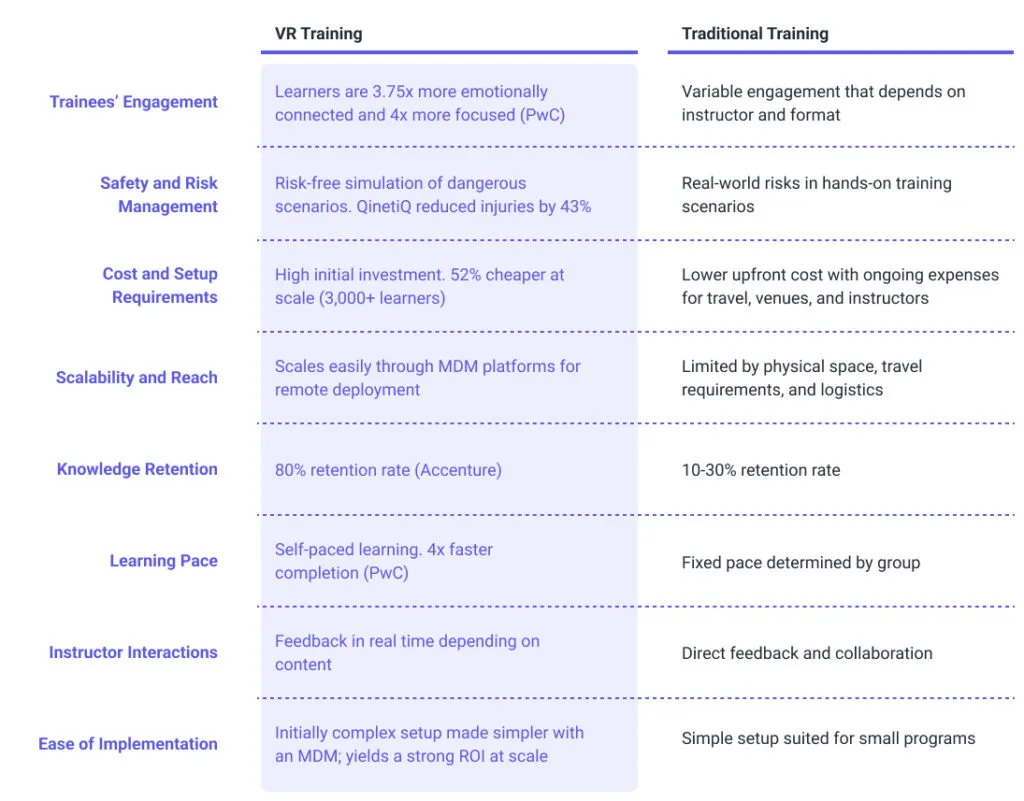Traditional training—meaning gathering employees in a room to review slides and practice skills—has been a cornerstone of employee development for decades and is still effective for many learning objectives.
But lots of organizations are enhancing these proven methods with VR training to address growing needs in safety training, cost efficiency, and scalability. VR’s ability to simulate dangerous scenarios safely, reduce travel expenses, and deliver consistent training at scale makes it an increasingly attractive complement to traditional classroom instruction.
Walmart has trained over a million employees using VR so far and they aren’t looking back.
But we’re well aware that switching from established systems isn’t a simple decision. That’s why we’ve created this guide comparing VR and traditional training. We’ll break down the strengths and key factors of each approach to help you make the right choice for your team.
An Overview of VR Training vs. Traditional Training
Corporate trainers invest countless hours designing classroom programs that deliver results.
These proven methods foster personal connections and spontaneous discussions that deepen understanding. However, L&D teams increasingly struggle with the complicated logistics and costs that go hand in hand with many traditional training programs.
VR training is quickly becoming a powerful complement to traditional, classroom training. VR training creates immersive, repeatable learning environments where employees can work on everything from social skills to safety protocols with fewer risks and lower costs at scale.
Each approach brings advantages to the table—the key is knowing when (and how) to use each one effectively.
VR Training vs. Traditional Training: Comparison Table
Before we dive into the full comparison, here’s a quick overview of how these two methods stack up in key areas:

What Is VR Training?
VR training uses virtual reality to create realistic learning environments where users can practice tasks and build skills safely, without any real-world risk.
Take Numix’s Molten Metal Safety VR module as an example.
The program guides trainees through the complete aluminum furnace process—from checking for hazards to sorting waste. Trainees perform these tasks in a virtual space that mirrors their actual work environment, gaining hands-on experience in a controlled setting.
Why should you care?
So, how does it all work? VR training relies on three core components:
- VR Headsets: Devices like the Pico 4E and Lenovo ThinkReality VRX that immerse users in 3D environments.
- Peripherals: Controllers, gloves, and body trackers that enable natural interaction with virtual objects.
- Software Platforms: Tools for creating and managing VR headsets and training content, including MDM platforms like ArborXR.
What is Traditional Training?
We’re all familiar with traditional training—a structured approach where participants come together in a physical (or virtual) space to learn from a trainer. These sessions usually follow a set curriculum and often include presentations, hands-on practice, and live demos—though the format can vary quite a bit.
Here are some common examples:
- Classroom-Based Sessions: Formal learning in a classroom setting with presentations and discussions.
- Instructor-Led Workshops: An instructor guides participants through exercises and demonstrations.
- On-the-Job Training: Practical, task-based learning conducted directly in the work environment.
- Group Interaction: Training often includes group activities or discussions facilitated by the instructor.
- Physical or Digital Materials: Learners may use tools, equipment, printed materials, or digital resources as part of the training.
5+ Use Cases for VR Training in Logistics
1. Trainees’ Engagement
VR training drives higher engagement than traditional methods.
That’s not just an opinion based on anecdotal experiences—though we have plenty of those too. It’s backed by hard data. PwC research shows VR learners are 3.75x more emotionally connected to content and 4x more focused than classroom learners. They’re also 2.3x more engaged than virtual learners.
Want a real-world example? At Bank of America, Senior Vice President Michael Wynn observed: “The reaction to VR was the same wherever we ran it—employees were having fun. They were so excited, they even talked about it with their families at the dinner table.“
“The reaction to VR was the same regardless of where we ran it – employees were having fun. They were excited about it to the point they were actually talking to their family about it at the dinner table.”
Michael Wynn
Senior Vice President, Innovations and Learning Technology Executive for The Academy
So, what’s driving this extra engagement? It mostly comes down to two things:
- Immersive Experiences: Learners interact directly with simulated environments, making training feel real and memorable.
- Active Participation: Instead of passive listening, trainees actively engage with content, maintaining focus and reducing distractions.
2. Safety and Risk Management
Traditional training for high-stakes fields like construction, surgery, and manufacturing carries inherent risk. Even the smallest mistakes during training sessions can cause serious injuries or damage.
VR training removes these risks entirely. Employees can practice handling complex situations—like operating heavy machinery, working with hazardous materials, or performing medical procedures—in a safe, controlled virtual environment.
The impact? Just look at QinetiQ. By using VR to train employees on coal mine safety hazards, they cut lost time injuries by 43% while growing their workforce by 60%+. That shows the power of being able to practise dangerous situations without the dangerous elements.
3. Cost and Setup Requirements
It’s true, VR training does cost more than traditional training upfront. You’re looking at tech investments, content development, software fees, and other more hidden setup costs that come along with implementing a VR training program.
But as you scale, VR training becomes much more cost effective than traditional training.
Let’s get specific. According to one in-depth study, traditional training averages $229.79 per person, while VR starts at $327.78. But after three years? VR drops to just $115.43 per person. Scale that to 3,000 learners, and PwC found VR training becomes 52% cheaper than classroom training.
What drives these savings? We believe there are three driving factors:
- No Travel Costs: VR training can be done anywhere, eliminating travel and accommodation expenses for trainers and trainees.
- Repeatability and Scalability: Once developed, VR modules can be used repeatedly with no extra cost, unlike traditional methods that require instructors and space.
- No Physical Training Space Needed: VR removes the need to rent or maintain training facilities, saving organizations a bundle.
Take Delta Airlines, for example. Previously, they spent $500 per foot of deicing fluid for staff training—expensive, wasteful, and travel-heavy. By switching to VR, they eliminated fluid waste, cut travel expenses, and started saving millions annually.
4. Scalability and Reach
VR training scales naturally. Unlike traditional training—where expanding means coordinating more spaces, travel, and logistics—VR lets you train employees across multiple locations seamlessly. But that doesn’t mean scaling VR training is automatic.
You need the right foundation—particularly a VR MDM (mobile device management) platform like ArborXR. Without an MDM, managing a fleet of VR devices becomes chaotic. Imagine updating content or configuring devices spread across different locations one by one. Not exactly efficient.
ArborXR solves these challenges with:

- Remote Device Management: Configure settings, update software, and monitor device health from one easy-to-use dashboard.
- App Deployment: Push new content or updates to all devices remotely.
- Experience Management: Remotely reboot headsets, launch content on all devices at once, and monitor user activity using a remote view.
- Single and Multi-App Kiosk Modes: Lock devices into a specific training app with Kiosk Mode or a set of apps with ArborXR Home to keep trainees focused and prevent unauthorized use.
- Release Channels: Deploy different app versions to select devices or groups as needed.
- Content Usage Analytics: Track content usage across devices to gain insights into engagement and training effectiveness.
5. Knowledge Retention and Transfer
VR training often leads to better knowledge retention and transfer compared to traditional methods.
Accenture found that employees forget 70% of what they learn in traditional training within a day—and 90% within a month. Why? Because traditional training is heavy on theory and light on hands-on practice.
VR training, on the other hand, is immersive and engages multiple senses, which makes learning stick. According to the same Accenture study, VR can help employees retain up to 80% of what they learn, even a year later.
Bank of America saw this benefit firsthand, with trainees reporting a 97% confidence level in applying what they learned.
6. Learning Pace
Traditional training moves at the instructor’s speed—too slow for some, too fast for others. VR training flips this dynamic by letting learners control their pace. They can speed through familiar content or take extra time with challenging scenarios, revisiting them as often as needed.
The data backs this up—PwC found VR learners complete training four times faster than classroom learners. This acceleration makes VR training a great complement to traditional classroom sessions. It lets organizations enhance their existing training programs with immersive practice modules while maintaining valuable in-person instruction where it matters most.
And while the study leaves it at that, it’s also important to consider what a 400% increase in training speed might mean for your business in terms of:
- Time saved on employee training
- Faster deployment of new skills
- Reduced time away from core duties
- Lower overall training costs
- Accelerated onboarding cycles
7. Instructor Interactions
Traditional training shines when it comes to instructor interaction. Real-time guidance, personalized feedback, and collaborative learning happen naturally in a physical classroom. Quick questions get quick answers, creating a dynamic learning environment.
VR training takes more effort to achieve this level of interaction. While some VR platforms include features for live coaching and virtual classrooms, they typically require additional tech. Think VR-compatible communication tools or multi-user setups for real-time instructor engagement.
The bottom line? Without these upgrades, instructor-student interaction in VR isn’t as seamless as face-to-face training.
8. Ease of Implementation
We’d say implementation complexity really depends on your training needs.
Traditional training usually wins for simplicity, especially with basic programs. Most organizations already have what they need—training rooms, standard materials, and basic AV equipment. It’s a straightforward choice for companies with limited tech resources or smaller training needs.
But traditional training isn’t always simple. Complex programs like Delta’s deicing training can be surprisingly challenging to implement. VR shines in these situations because it eliminates physical constraints, reduces resource waste, and creates consistent training experiences across the organization.
The trade-off? More upfront hurdles. You’ll need to invest in hardware, IT support, and software. But once you clear these initial obstacles, the system runs smoothly and scales efficiently.
Simplifying VR Training with ArborXR
The choice between VR training and traditional methods isn’t necessarily an either-or decision.
Many organizations use VR to supplement their traditional training programs, creating a blended approach that maximizes the benefits of both methods. While VR training excels in scalability, effectiveness, and potential long-term cost savings, traditional methods provide irreplaceable human interaction and foundational learning experiences.
If you’re thinking about giving VR training a shot, ArborXR can make the transition smooth. With ArborXR, you can manage and deploy headsets at scale, push apps and updates remotely, and create seamless single or multi-app kiosk experiences.
Ready to take your training to the next level? Start your 30-day free trial with ArborXR and see how easy it is to manage VR training for your organization.

